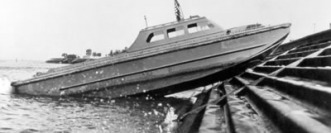"A.J. Higgins engaged upon the most unique type of ship construction ever attempted in the world." -War Shipping Administration's Jerry Land, 1942
(click photos to enlarge)
Higgins Industries

The 7,000th LCVP ready for transport, Challenge LCVP
In 1906, Higgins moved to the South to pursue his interests, boats and lumber. Higgins began his own lumber exporting business, the A. J. Higgins Lumber and Export Company in 1916 in New Orleans. However, by the early 1920s, his business began focusing on boat design and manufacture, and Higgins Industries, Inc. was formed.
The Eureka

Eureka test run up concrete sea wall, ca. 1939, Strahan
Seeing the need for shallow draft boats for his business as well as for oil exploration, Higgins experimented with boat design. According to a 1940 Time article, in the early 1930s, Higgins invented the Eureka, with a design purpose "to enable the boat to crunch through driftwood, bounce over logs, hurdle narrow land spits, climb a beach, land a party dry-shod," and "wham up on a sloping concrete sea wall."
"Sailin' On the Robert E. Lee," Sydney Firman & His Band, 1932
Speed and Maneuverability

Eureka jumping obstacles, ca. 1939, Strahan
Noting the lines of blue whales, Higgins decided to design his boat after these mammals, known for their maneuverability and speed. The result was a boat that had a turning radius shorter than the hull because as the boat made a full turn, it essentially revolved around a point slightly aft of amidships. Higgins also resolved the problem of cavitation, costing the boat 40% of its engine power. In 1936, Higgins and his engineers designed a v-shaped keel amidships and a reverse curve aft with, according to War Machines, the resulting hydrodynamic characteristics: "objects and froth near the bow and amidships tended to be pushed to the side while solid water was drawn directly into the tunnel toward the screw." These innovations resulted in increasing the boat’s speed by nearly 10% to 12 knots. Proving the design changes, the boat broke the record of the legendary river steamer Robert E. Lee for the 1,200-mile upriver run from New Orleans to St. Louis in 1929, in 87 hours.


